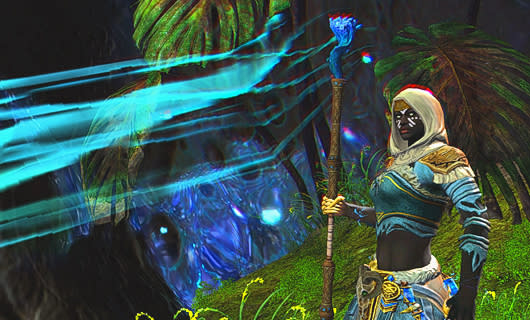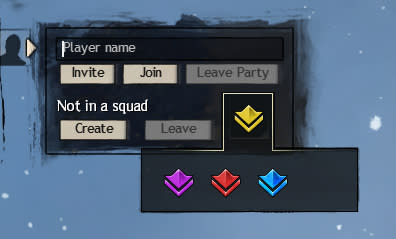Flameseeker Chronicles: Taking command in Guild Wars 2

Last week, ArenaNet wrapped up Guild Wars 2's two-parter story arc, The Dragon's Reach. It's a doozy, especially since part one of the chapter was, in my opinion, the weakest of the living world story's second season so far. It wasn't bad, mind you; it just didn't leave me staring at my calendar in thwarted anticipation the way previous installments did.
Part two brings that feeling back, which is almost too bad since we're going to be waiting until autumn for the story to start up again. In the meantime, we've got a bunch of stuff to talk about, so jump past the cut -- but only if you're cool with spoilers for pretty much everything.
Shedding light on the shadow
The gameplay in this update was fantastic overall. As much as I enjoy GW2's combat system, fighting monsters -- especially solo -- doesn't usually ring my bell enough to make me seek out battles. Any instanced fight that flings waves of trash enemies at me gets old fast, especially since those in the season two instances don't drop loot.
The two big boss battles of the chapter -- a Mordrem leecher and the Shadow of the Dragon -- rely pretty heavily on the "kill lesser enemies to get back into the fight" mechanic, especially the latter. That said, both were difficult and fast-paced enough that I didn't catch myself yawning. Mechanically, I enjoyed the fight with the leyline leecher far more; it has quite a bit more variety in its phases and does an excellent job of teaching the fight as it goes before wrapping it all up neatly at the end. I found the Shadow of the Dragon less fun to fight, but ArenaNet hit on something very important with it: This is what fighting a dragon should feel like. It was dangerous, the atmosphere was great, and the dragon itself was impressive and menacing.
Speaking of the Shadow of the Dragon -- how about that, huh? This boss is an old friend of Sylvari players, and the first big fight they encounter in the starting tutorial. The beginning of the Sylvari personal story has long been speculated to be something of a narrative shell game because the information your character is given about the Shadow of the Dragon implicates Zhaitan as the source. Mordremoth is never mentioned at all, and the player and main character are left to draw their own conclusions.
It turns out that many people never stopped to examine exactly what went on there, and I'm pretty sure that was intentional. No possible explanation involving Zhaitan stands up to scrutiny, but on a player's initial trip through the game, none of the details sticks out as being particularly noteworthy, either. It isn't until you've absorbed quite a bit of the lore that the incongruity starts to rear its head.
The payoff when the Shadow of the Dragon shows its face at the world summit to attack the Pale Tree is huge. It didn't represent Zhaitan in the Dream; it was an actual minion of Mordremoth. For a Sylvari character, being trapped alone to fight the Shadow in reality while the Pale Tree lies helpless is a powerful and horrifying parallel.

Tonight we're gonna party like it's 1327 A.E.
Both Countess Anise and Canach were brilliant in this update, and they play off of each other wonderfully. Despite my earlier reservations, I was happy to see that Anise seemed much less sinister (although no less sneaky) this time around.
I don't care for the very popular speculation that Anise is Guild Wars Hero Livia in disguise. There are a few details that make it somewhat plausible, but much of the theory hinges on mechanical possibilities rather than actual similarity between the characters. Characterization is the biggest sticking point for me; although Livia's had a long life and she certainly could have changed, she's different enough from Anise that the reveal would feel a little pointless to me. The reason I'm rooting for Livia's return is so that I can see the character I know, and I like Anise as her own person. Livia's rough edges, which she would have had to polish quite a bit to carry off Anise's noble social butterfly role, were part of her charm.
Livia was a dedicated Necromancer, while Anise is a powerful Mesmer, but there's a chance that could be explained as an effect of the Scepter of Orr or simply Livia's having had the time to maintain study into dual professions. I just think it'd be quite a stretch, especially since their respective professions have informed so much of their individual characters. It would also unintentionally showcase the curious shift in Krytan demographics in the space between GW1 and GW2. In GW1, Kryta and its people looked much different from Ascalon and Ascalonian natives, but GW2 shows little difference between the two, with appearances skewing toward white Ascalonians despite the relatively small number of them who survived both the Searing and the Foefire. It would be a depressing statement on the rarity of ethnic Krytans if dark-skinned Livia had to disguise herself as light-skinned Anise to avoid suspicion.
I'd rather find out that one of my favorite GW1 Heroes is working closely with Anise and that we'll find her taking action directly against the White Mantle. During Anise's party, we got a reminder of both the Mantle's existence and their involvement with human bandits, who are in cahoots with Minister Caudecus. It might not lead anywhere, and I've certainly been off the mark before when speculating that the story could veer into Mantle territory, but to my delight, season two of the living world has so far done a lot to follow up on existing plot threads. I loved talking information out of Anise's party guests -- especially as a human noble -- but the first instance of the chapter also doubled as a refresher course in the Krytan Ministry's twisted politics for players who may never have played through relevant arcs of the personal story.
The final cutscene of this chapter could mean any number of things, especially since it's not clear how much of what the Pale Tree showed us might have been a vision of actual events and how much was symbolism. Because we know so little, I haven't formed any sort of opinion on what might explain it. My favorite of the circulating theories is that the structures rising up into the heavens and the purple crystals represent a Mursaat city of the sort Saul D'Alessio stumbled on long ago. It's probably more likely to have to do with Glint's lair, the Crystal Desert, and whatever the Zephyrites' Master of Peace escaped with in his bag, but the sky imagery and the presence of the Shadow of the Dragon are very interesting. In our first glimpse of Mordremoth, it opens its mouth to reveal -- of all things -- what looks like sky and clouds.
Finally, as excited as I was to see Trahearne, I was disappointed in the way he was written. Much of his dialogue was slanted toward patting the player character on the back and downplaying his own importance, which seemed like an attempt to soothe players who still feel that Trahearne stole their spotlight. If you thought his dialogue was too dry and detached in the personal story, it came off as even worse here; I'm a fan of the character, but I don't think having him all but say "I'm not as important as you" in lieu of building him up to be more interesting is the way to go. I hope that if he's going to feature in the living world story in the future that his character isn't held back for the sake of the player character; if anything is going to improve how he's received, it's making him less passive.
Each of the main characters we interact with is arguably as important as the player character, even if we're technically "the boss." The main reason I believe Trahearne was so widely disliked is that he wasn't explored much outside of becoming leader of the Pact; people who played through the Sylvari arcs, in which he's introduced early and given a role more suited to his character, tend to report more positive feelings toward him. Like GW1's equally controversial Kormir, he's a character with lots of interesting implied quirks and character traits, very few of which are given the chance to inform how he's actually written. Tell us about the cats in the guy's office or something.

Packing heat
Aside from the story chapter, we've gotten confirmation that GW2's second feature pack is on its way and will go live on September 9th. ArenaNet plans to release information about what we can expect in daily chunks, so we've got a lot to look forward to.
So far, most of the info has concerned World vs. World and structured PvP. Color variation for WvW commander tags has been a long-requested feature, and we know now that it'll be in the feature pack -- but some additional answers from Gamescom seem to indicate that each color will need to be purchased separately for the full price of a tag.
I'm not a dedicated WvW player, and I've never been even slightly tempted to buy a commander tag, but if ArenaNet really intends to charge separately for each available color, I strongly urge the developers to reconsider. Players wanted more colors so it would be easier to organize large groups with multiple commanders, both in WvW and at split-team PvE events like Bloodtide's jungle wurm. Putting that functionality behind a gold sink is frankly baffling.
Even stranger, the price for a tag is being tripled. This makes sense on its own: The new tags will be account bound instead of character bound, and players have suggested making tags more difficult to acquire for some time. Charging a full-price fee for extra colors, though, defeats the purpose of both the colors and the barrier to entry: Some players splash out for a tag just to wear it because it costs a bunch of gold and puts your name on the map. Having six or so commanders on a map is no guarantee that all of them plan to do any actual commanding. Several different colors to swap between would make it much easier to direct players to active commanders, but in choosing to charge 300 gold for each color, ArenaNet will reinforce the idea that commander tags are gold-based vanity items, not tools for organization.
It's disappointing that ArenaNet could come up with this implementation after WvW players have written eloquent explanations of how they'd like to see commander tags improved. If extra colors cost anything at all, it should be in a currency other than gold, but the ability to easily use them for a purpose beyond "Hey guys, look at my purple Dorito" should come first. Otherwise, active commanders are going to have to raise a massive amount of gold just to unlock a basic quality-of-life feature... or stick to blue pins and designate the guy with a fashionable purple pin farming wood in the corner of the map as the commander to avoid.
Did you enjoy the latest update? Are you looking forward to a break for more non-story content? Raise your hand if you feel like drop-kicking Phlunt straight into the Eternal Alchemy itself. Talk about it in the comments, and I'll see you in the Mists!

Anatoli Ingram suffers from severe altitis, Necromancitosis, and Guild Wars 2 addiction. The only known treatment is writing Massively's biweekly Flameseeker Chronicles column, which is published every other Tuesday. His conditions are contagious, so contact him safely at anatoli@massively.com. Equip cleansing skills -- just in case.

